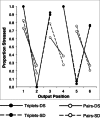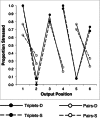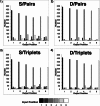A matter of emphasis: Linguistic stress habits modulate serial recall
- PMID: 25280733
- PMCID: PMC4555234
- DOI: 10.3758/s13421-014-0466-2
A matter of emphasis: Linguistic stress habits modulate serial recall
Abstract
Models of short-term memory for sequential information rely on item-level, feature-based descriptions to account for errors in serial recall. Transposition errors within alternating similar/dissimilar letter sequences derive from interactions between overlapping features. However, in two experiments, we demonstrated that the characteristics of the sequence are what determine the fates of items, rather than the properties ascribed to the items themselves. Performance in alternating sequences is determined by the way that the sequences themselves induce particular prosodic rehearsal patterns, and not by the nature of the items per se. In a serial recall task, the shapes of the canonical "saw-tooth" serial position curves and transposition error probabilities at successive input-output distances were modulated by subvocal rehearsal strategies, despite all item-based parameters being held constant. We replicated this finding using nonalternating lists, thus demonstrating that transpositions are substantially influenced by prosodic features-such as stress-that emerge during subvocal rehearsal.
Figures









Similar articles
-
The Working Memory Model and the relationship between immediate serial recall and immediate free recall.Q J Exp Psychol (Hove). 2025 Feb;78(2):310-336. doi: 10.1177/17470218241282093. Epub 2024 Nov 1. Q J Exp Psychol (Hove). 2025. PMID: 39223965 Free PMC article. Review.
-
Conditional recall and the frequency effect in the serial recall task: an examination of item-to-item associativity.Mem Cognit. 2012 Nov;40(8):1246-56. doi: 10.3758/s13421-012-0221-5. Mem Cognit. 2012. PMID: 22696222
-
Examining the relationship between free recall and immediate serial recall: the effects of list length and output order.J Exp Psychol Learn Mem Cogn. 2010 Sep;36(5):1207-41. doi: 10.1037/a0020122. J Exp Psychol Learn Mem Cogn. 2010. PMID: 20804293
-
How is the serial order of a visual sequence represented? Insights from transposition latencies.J Exp Psychol Learn Mem Cogn. 2018 Feb;44(2):167-192. doi: 10.1037/xlm0000440. Epub 2017 Sep 14. J Exp Psychol Learn Mem Cogn. 2018. PMID: 28910129
-
Give me enough time to rehearse: presentation rate modulates the production effect.Psychon Bull Rev. 2024 Aug;31(4):1603-1614. doi: 10.3758/s13423-023-02437-5. Epub 2024 Jan 2. Psychon Bull Rev. 2024. PMID: 38169042
Cited by
-
Perspectives on working memory: introduction to the special issue.Mem Cognit. 2015 Apr;43(3):315-24. doi: 10.3758/s13421-015-0510-x. Mem Cognit. 2015. PMID: 25802028
-
The Item versus the Object in Memory: On the Implausibility of Overwriting As a Mechanism for Forgetting in Short-Term Memory.Front Psychol. 2016 Mar 10;7:341. doi: 10.3389/fpsyg.2016.00341. eCollection 2016. Front Psychol. 2016. PMID: 27014148 Free PMC article.
-
Recalling visual serial order for verbal sequences.Mem Cognit. 2016 May;44(4):590-607. doi: 10.3758/s13421-015-0580-9. Mem Cognit. 2016. PMID: 26704711 Free PMC article.
References
-
- Baddeley AD. A three-minute reasoning test based on grammatical trans-formation. Psychonomic Science. 1968;10:341–342. doi: 10.3758/BF03331551. - DOI
-
- Baddeley AD, Hitch GJ. Working memory. In: Bower GH, editor. The psychology of learning and motivation: Advances in research and theory. New York, NY: Academic Press; 1974. pp. 47–89.
Publication types
MeSH terms
LinkOut - more resources
Full Text Sources
Other Literature Sources

